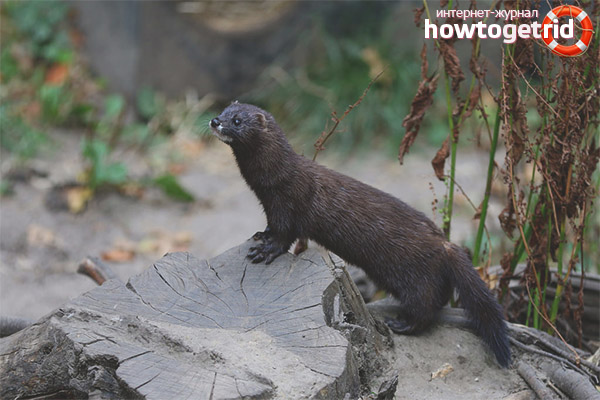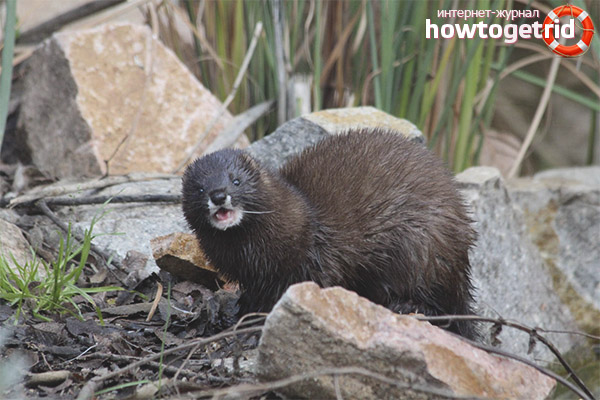The content of the article
Species European mink belongs to the family marten. In terms of external characteristics, this animal is very similar to a ferret or a column, and the dimensions and general structure of its body are very similar to other small animals that belong to the Kunim. The male in adulthood has a body length of about 30-45 cm, while the length of the tail is on average 12-16 cm.
Appearance
These minks have an elongated trunk, legs are rather short. Between the fingers there are swimming membranes. On the hind legs they are very well developed. The head of the representatives of the species is medium in size, the muzzle is somewhat blunt. The ears are wide, but not tall. The length of the tail does not exceed the length of the body of the European mink.
In winter, the body is covered with very dense and thick fur. It is silky to the touch, glistens beautifully in the sun. But at the same time their winter coat is short. Since the animal spends most of its time near the water, this affected the structure of its fur. The underpush is well developed, grows densely. From above, covering hairs grow that shine in the sun. The density of the skin is almost the same over the entire surface of the animal’s body. But on the tail and legs, the wool is not fluffy, it is snug.
In winter, the fur has a predominantly dark brown color. But some minks become brown or almost black. In summer, the fur becomes even shorter, it is more rare and not so shiny. The color remains almost the same, but acquires a reddish tint and brightens a little.
The whole body of these animals is monochromatic. But there are white marks on the lips and chin. White spots of various shapes can also be on the chest or neck.
Habitat
By mail, all representatives of this species live in Russia, but only in the European part of the country. Sometimes these animals can also be found near the tributaries of the Ob.
Today there are several subspecies of European mink. It is northern, central Russian, as well as central European. There is another subspecies - the North Caucasian mink.
In recent years, a very low abundance of the species. Moreover, it is constantly declining in our time. Previously, this animal could be seen everywhere in the area. Today it is very rare. Animals prefer to settle in the most favorable conditions for themselves. The low population density of the range, as well as a decrease in numbers, are due to the fact that recently, representatives of the species have been crowded out by the American mink. In addition, many water bodies dry up, and the rest become unsuitable for the life of this animal.
As a rule, minks prefer to settle near forest rivers and streams, which in winter do not completely freeze. For the mink, the depth of the reservoir does not matter. European species do not like to settle in large bodies of water, which cannot be said about American ones. They also shun territories where human settlements are nearby.
It is very important for a mink that there are hollow ice in winter, from which they get their livelihood. They do not settle throughout the territory for several reasons: along the coastline, they feel unsafe if the area is cluttered, swampy, or there are too thick bushes on it. They do not settle where the pond freezes completely. These animals live mainly near the coast, even in search of food they do not depart from the reservoir further than 100 m. One individual moves through the territory no more than 2-3 km.Her habitat depends on whether she can find enough food on it.
Lifestyle

The mink shelter is a hole. They equip them on their own, but sometimes they can settle in the mink of a muskrat. Mink can have several dwellings. This is one permanent and several temporary.
The constant burrow is brood. Animals arrange them on the shore of a reservoir in a fairly dry place. Usually these minks are located under the roots of the tree and next to the water. Minks make 1-2 entrances to their permanent hole. If the coast is very steep, the entrance may be under water.
The stroke length is 1-1.5 m. Next is the nesting chamber of a relatively small size. The animal is lining it with grass and a bird feather. In addition to this main hole in the habitat, the animal makes several more shelters for itself. They can be under the roots of large trees or in the hollow of a fallen tree. Mink chooses a place. Where can she hide from the enemy.
What does it eat?
The nutrition of these animals is diverse. They are predators, so they seek food in the water and on the coastal territory. Depending on the time of year, yield, as well as the diversity of fauna in this particular area.
In winter, the European norm feeds mainly on small rodents, frogs, as well as fish. If there is enough food, the animal stores it. In the warmer months, these animals can hunt at any time of the day. But most often they are looking for prey at night, at dawn or at sunset.
Twice a year, these animals are particularly active. The first time is in the spring, when the otter mating season begins. In autumn, young individuals settle, animals seek a more favorable area for life.
Since the mink usually lives very secretively, it is difficult to see it in nature. Fishermen meet this animal in the early morning.
The fact that the mink lives on the shore can be said in characteristic traces. They are similar to the tracks left by the ferret, but more rounded and larger in size. The mink puts its paws somewhat wider than the ferret.
During the day, these animals can travel different distances. In summer and autumn, it is up to 500 m. In winter it is up to 200 m. You can also distinguish mink traces from ferret traces by the fact that she has a very fussy move.
Breeding

The breeding season of minks falls in the second half of April. The duration of pregnancy is approximately 1.5 months. 3-7 cubs are born at a time. They are born small, their eyes are closed. The female feeds them milk for 2 months, but when they turn about a month old, she begins to accustom them to ordinary food. Kids grow up very fast. Already in July, they are selected from the maternal mink, and a month later they are able to get their own food.
In autumn, the cubs disperse, begin to live independently. They find for themselves the territory along the coast, dig holes. The molting period lasts from spring to early winter.
Enemies
The most dangerous enemy for representatives of this species in nature is the otter. If an otter wants to settle in a mink, it can drive it out or kill it. Also competing for them is the American mink and forest ferrets.
Previously, this animal was considered a source of valuable fur, but today they are very few. Today it is a rare animal, it is impossible to hunt them.
Video: how to keep a mink at home?










Submit